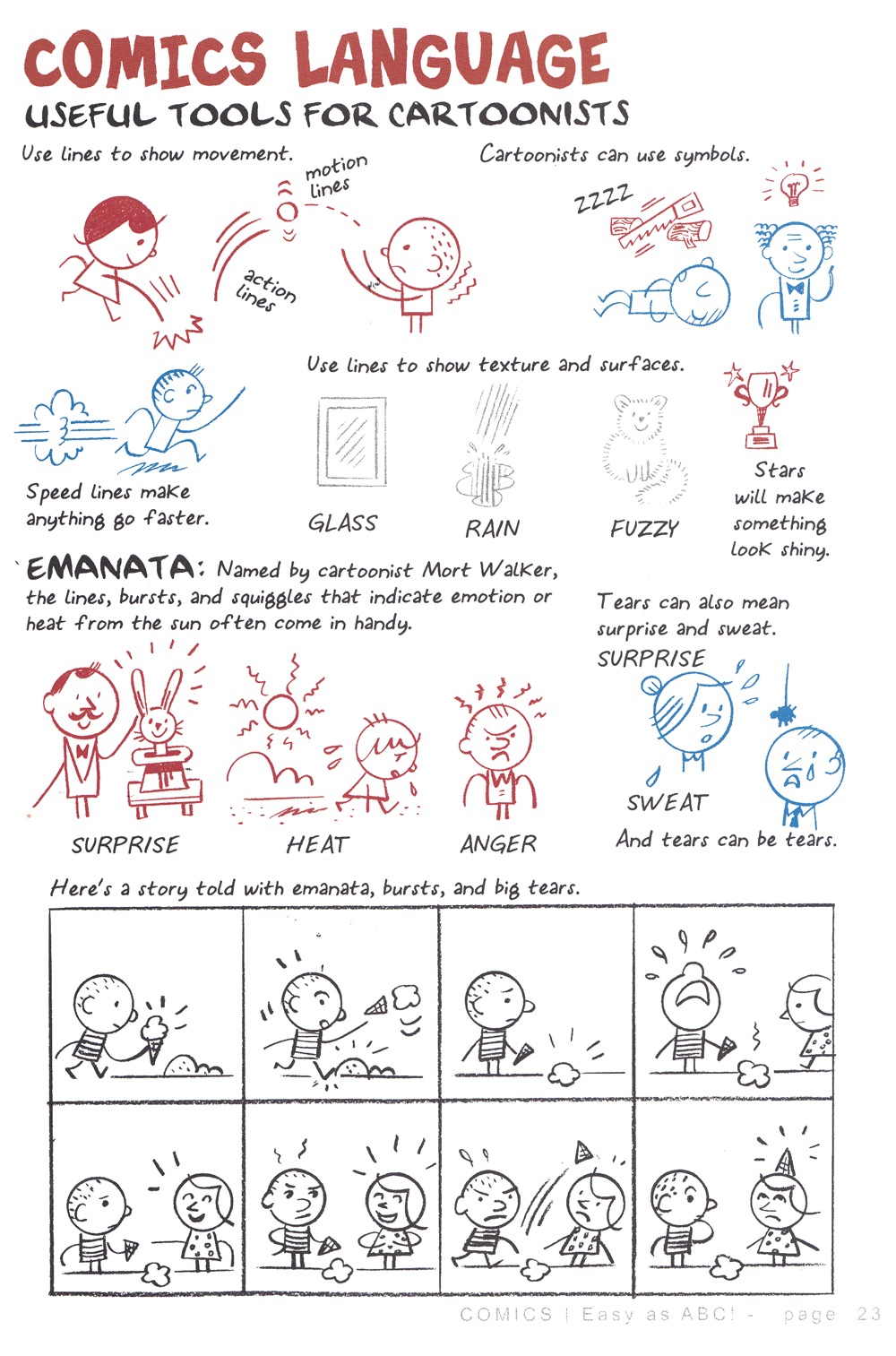|
Comics: Easy as ABC! By Ivan Brunetti. Edited and designed by Françoise Mouly. With contributions by Eleanor Davis, Elise Gravel, Geoffrey Hayes, Liniers, Sergio García Sánchez, Art Spiegelman, and others. TOON Books, 2019. ISBN 978-1-943145-39-3 (softcover), $9.99; ISBN 978-1-943145-44-7 (hardcover), $16.95. 52 pages. A Junior Library Guild Selection. This is meant to be a book "for kids." I'll be using it next term as a textbook in a college class. That ought to tell you something. Comics: Easy as ABC! is both a book by Ivan Brunetti and a showcase for the entire TOON Books line. Not for nothing does the spine say Brunetti/Mouly, pointing to the crucial role of TOON's editorial director, Françoise Mouly, who commissioned, edited, and designed the book, drawing on a who's who of TOON authors to complement and fill out Brunetti's text. I imagine that this book was her idea; I note that it reuses the "coaching tips" for parents and educators found on TOON's website. In any case, Comics: Easy as ABC! works as both a young reader's adaptation of Brunetti's pedagogy, as modeled in his previous instructional book Cartooning: Philosophy and Practice (Yale, 2011), and a distillation of Mouly's (and TOON's) editorial ethos. That ethos brings kid-friendly storytelling and cartooning into contact with frank avant-gardism (shades of The World Is Round!). Who would have thought that Brunetti, author behind the scabrous, post-Crumbian Schizo and other bitter, depressive, and often savage alt-comix, would become one of TOON's signature authors, and an ambassador for children's cartooning? The mind reels. But the role suits him, and his methods can help adults as well as kids. Anyone who has carefully read (or has taught) his Cartooning textbook knows that his pedagogy is precisely the sort to encourage those who "can't draw"; Brunetti extols comic art not as illustration but as a form of "writing with pictures" accessible to almost everybody. Whereas Cartooning imagines itself as a syllabus crafted by an authoritative (and strict) teacher with a classroom of official students, Comics: Easy as ABC envisions an audience of free-spirited kids with time on their hands, doing what they want to do. A comparison to Lynda Barry's new Making Comics may help: whereas Barry exhorts her adult students and readers to recover the openness and energy of childhood drawing, Easy as ABC aims right at kids themselves (though with imagined grownups peeking solicitously over the kids' shoulders, as it were). The result is a dual-purpose book: part how-to for a young (or any aspiring) cartoonist, part exhortation to "parents, teachers, and librarians." Woven through Brunetti's pages of advice and demonstration are miscellaneous contributions from other cartoonists, with those by Elise Gravel, Sergio García Sánchez, Art Spiegelman, and the late Geoffrey Hayes being perhaps the most substantial. Benny and Penny pages by Hayes, endpapers by Gravel, a draw-your-own-conclusion strip by Spiegelman, a (too dense?) page on perspective by García Sánchez—the book is filled with diversions. Short, elliptical strips by various artists from the 4PANEL Project website insinuate an art-comics vibe by means of a traditional comics structure. Sprinkled here and there throughout the book are blurbs labeled "What works?" that offer advice either to artists or to adults coaching children through comics-reading. It's a Whitman's Sampler on the surface, a deliberate curriculum underneath. All the "extras" are good, but what most matters to me is Brunetti's teaching method. Mixing brief texts with scads of drawn examples, he starts the budding cartoonist with encouragements to doodle and experiment with basic shapes and free mark-making. He then progresses to faces, emotions, schematic character design, bodies, body language, and point of view. Eventually he gets to comics-specific devices such as emanata, word balloons, and page layout (the back matter includes an index of comics terms). Brunetti's approach is disarmingly accessible, without stinting on specific vocabulary and questions of technique. This is why I want to use this book in my university Comics class: even more than Brunetti's Cartooning, this book lays out, very clearly, basic storytelling and craft conventions that my students will need to think about as they prepare their final comics projects (and the various short exercises that will lead up to and scaffold those projects). I could quibble with some of the book's claims. Consider, for example, this exhortation to rapid-fire doodling: “When we have no time to think about the drawing, we get closer to the idea of the thing being drawn” (6). This idea that the quiddity or basic “whatness” of a thing is best conveyed without fussiness or craft, and without worrying about how to capture its visual particularities, fits Brunetti’s favored notion of comics as picture writing, but seems to deny the importance of observational drawing or the evocative this-ness of a distinctive drawing. At times, Brunetti’s advice seems designed to steer artists toward semiotically handy visual cliches. This is consistent with his ethos of writing over illustrating, and is likely to be liberating good advice for up and coming artists, but it soft-pedals the considerable effort often required to find distinctive, personal ways of rendering things as cartoons. If you believe that eloquence and distinctiveness of drawing are important, Brunetti’s embrace of simplicity and very familiar forms may grate on your nerves. On the other hand, I have given similar assurances to students in my (emphatically non-studio) classes (i.e. English classes), and I find that this sort of advice and exhortation does indeed serve to unlock visual storytelling. So, I dunno, maybe I should keep my big trap shut. In any case, I will be using this book next term! I expect it will be a great guide. It’s also a delightful read on its own terms, and a summation of what makes TOON Books such a terrific publisher.
0 Comments
|
Archives
June 2024
|




 RSS Feed
RSS Feed
